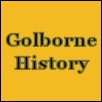
A thousand years ago, the area that is now Golborne Ward was part of the great forest of Middlesex. By the middle of the fifteenth century, this forest had been cleared to be replaced by meadows and farmland.
Golborne was part of the manor of Notting Barns, a detached part of the estate of Chelsea, and the area was still sometimes known as Upper Chelsea as late as the 19th century.
In 1543, Henry VIII seized the land, but as he died in 1547, he had little time to enjoy his new acquisition and there is no evidence that he ever visited.
Up to the 1870s, the area was farmland – the houses and shops of Notting Hill extended only as far south as Elgin Crescent. The land north of that consisted of cornfields, meadows and a few farm buildings, right up to the village of Kensal Green on the Harrow Road. Portobello Road was known as Portobello Lane and was nothing more than a rough country track.
The name Portobello comes from Puerto Bello, a harbour town situated near the northern end of the present-day Panama Canal. The port was captured by the English navy from the Spaniards in 1739 and the victory was met with great jubilation in an England that regarded Spain as its bitter maritime rival.
As was the custom after a successful battle, many places took the name of Portobello, including Portobello Farm, situated where Portobello Road now meets Oxford Gardens. We can savour the irony that Portobello Road and around is now home to a large and thriving Spanish population.
The census of 1851 (which recorded only 214 names for the whole of Portobello Road) mentions the owner of Portobello Farm, ‘George Wise Esq. gentleman farmer of 175 acres…’ and adds that he had eighteen household servants and farm hands.
Opened in 1801 with a ceremony at Paddington Basin attended by 20,000 people who were entertained by the ringing of bells and volleys of canon fire, the Grand Union Canal already formed the northern boundary of the area. The western edge of Golborne was defined by the Great Western Railway which opened in 1838.
By 1850, Kensal New Town was largely in place including East Row, Middle Row, West Row and South Row. Kensal Road, originally known as Albert Road, was also in existence by then and Kensal New Town was known as a “laundry colony”, that being the main occupation of the neighbourhood, many of whose inhabitants were Irish.
Kensal New Town still had something of a rural character, with many people keeping pigs and growing vegetables in their gardens. Pony-trotting and dog stealing were also said to be popular local pursuits.
A night market was held on Saturdays where Wedlake Street is now - it was notorious for rowdy scenes until an iron chapel was built on the site. The village had six public houses and organised pitched battles between the youths of Kensal Road and Lissom Green were popular up to the end of the nineteenth century.
Things began to change quickly after the opening of the Hammersmith and City Railway and the station on Ladbroke Grove (originally called Notting Hill) in 1864. That meant that people who were working in the City could now commute from Notting Hill and this stimulated the building of houses, shops and pubs on the farmland of Golborne. At the same time, British society was changing with many people leaving the countryside for the cities and some of them moved to new housing in Golborne.
In the 1870s, what had been a footpath leading from Portobello Road to Kensal Road was planted with trees and named Britannia Road. Later the trees were cut down and the street was called Golbourne and later Golborne Road. Originally, it had been intended that Golborne Road should cross Kensal Road to a bridge across the canal, so forming a direct connection with Harrow Road.
The population of the area between the railway and Portobello Road grew rapidly during the 1870s and 1880s, with the inhabitants described as ‘superior mechanics and railway employees’. Increasingly, houses that had been built for a single family were let by the floor and the area began to decline so that by the turn of the twentieth century much of it was slum housing.
In 1903, Golborne was described by Charles Booth, founder of the Salvation Army, as one of the worst areas in London. The living conditions in Southam Street, which in 1923 had 2,400 people living in 140 nine-roomed houses were recognised as being especially bad, a reputation that continued until its demolition in the 1960s. Now only a short remnant of the Street remains, off Golborne Road.
Golborne underwent much redevelopment in the 1960s and 70s. Slum housing was cleared and the 32-storey Trellick Tower was completed in 1968. The Westway also appeared on the south side of Golborne; it opened in 1970, with much protest from local people.
The other great changes that have happened in Golborne relate to the succeeding waves of newcomers. The Irish and Welsh arrived in numbers in the second half of the nineteenth century and into the twentieth. In the 1950s, many came from the Commonwealth countries of the Caribbean, attracted to the area by cheap, if insalubrious, housing. At about the same time many people arrived from Spain and Portugal – the first Spanish had actually come as refugees from the Spanish Civil War in 1937.
Notting Hill has also become home to the largest Moroccan population in England, with many of those settling in Golborne. A variety of other groups have made their home in Golborne over the last two decades, many of them fleeing war in their own countries, including people from Eritrea, Ethiopia, the Sudan and Somalia. Henry VIII would be hard pushed to recognise the forest land that he briefly owned.
Much of this article has been written using material from Notting Hill in Bygone Days by Florence Gladstone & Ashley Barker and Portobello, Its People, Its Past, Its Present by Shaaron Whetlor & Liz Bartlett (Kensington & Chelsea Community History Group)
Home






